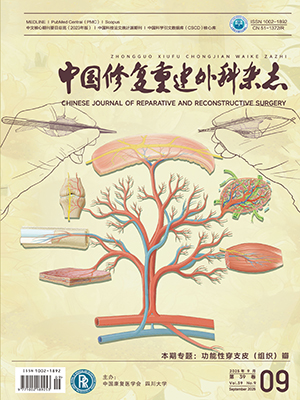| 1. |
Tsai TL, Nelson BC, Anderson PA, et al. Intervertebral disc and stem cells cocultured in biomimetic extracellular matrix stimulated by cyclic compression in perfusion bioreactor. Spine J, 2014, 14(9):2127-2140.
|
| 2. |
Sharifi S, Bulstra SK, Grijpma DW, et al. Treatment of the degenerated intervertebral disc; closure, repair and regeneration of the annulus fibrosus. J Tissue Eng Regen Med, 2014.[Epub ahead of print].
|
| 3. |
Yoon ST. Molecular therapy of the intervertebral disc. Spine J, 2005, 5(6 Suppl):280S-286S.
|
| 4. |
Miyamoto K, Masuda K, Kim JG, et al. Intradiscal injections of osteogenic protein-1 restore the viscoelastic properties of degenerated intervertebral discs. Spine J, 2006, 6(6):692-703.
|
| 5. |
Le Maitre CL, Freemont AJ, Hoyland JA. Localization of degradative enzymes and their inhibitors in the degenerate human intervertebral disc. J Pathol, 2004, 204(1):47-54.
|
| 6. |
Thompson JP, Oegema TR Jr, Bradford DS. Stimulation of mature canine intervertebral disc by growth factors. Spine(Phila Pa 1976), 1991, 16(3):253-260.
|
| 7. |
Pirvu TN, Schroeder JE, Peroglio M, et al. Platelet-rich plasma induces annulus fibrosus cell proliferation and matrix production. Eur Spine J, 2014, 23(4):745-753.
|
| 8. |
Sharifi S. The development of novel biodegradable polymeric biomaterials for use in the repair of damaged intervertebral discs. Groningen:University Library Groningen, 2012:16-51.
|
| 9. |
Bron JL. Novel regenerative strategies for the treatment of intervertebral disc herniation. ArgoSpine News & Journal, 2012, 24(3-4):147.
|
| 10. |
Shao X, Hunter CJ. Developing an alginate/chitosan hybrid fiber scaffold for annulus fibrosus cells. J Biomed Mater Res A, 2007, 82(3):701-710.
|
| 11. |
Turner KG, Ahmed N, Santerre JP, et al. Modulation of annulus fibrosus cell alignment and function on oriented nanofibrous polyurethane scaffolds under tension. Spine J, 2014, 14(3):424-434.
|
| 12. |
Bowles RD, Gebhard HH, Dyke JP, et al. Image-based tissue engineering of a total intervertebral disc implant for restoration of function to the rat lumbar spine. NMR Biomed, 2012, 25(3):443-451.
|
| 13. |
Gruber HE, Hoelscher G, Ingram JA, et al. Culture of human anulus fibrosus cells on polyamide nanofibers:extracellular matrix production. Spine (Phila Pa 1976), 2009, 34(1):4-9.
|
| 14. |
Sato M, Asazuma T, Ishihara M, et al. An atelocollagen honeycomb-shaped scaffold with a membrane seal (ACHMS-scaffold) for the culture of annulus fibrosus cells from an intervertebral disc. J Biomed Mater Res A, 2003, 64(2):248-256.
|
| 15. |
Le Visage C, Yang SH, Kadakia L, et al. Small intestinal submucosa as a potential bioscaffold for intervertebral disc regeneration. Spine (Phila Pa 1976), 2006,31(21):2423-2430.
|
| 16. |
Schek RM, Michalek AJ, Iatridis JC. Genipin-crosslinked fibrin hydrogels as a potential adhesive to augment intervertebral disc annulus repair. Eur Cells Mater, 2011, 21:373-383.
|
| 17. |
Park SH, Gil ES, Mandal BB, et al. Annulus fibrosus tissue engineering using lamellar silk scaffolds. J Tissue Eng Regen Med, 2012, 6 Suppl 3:s24-33.
|
| 18. |
Chang G, Kim HJ, Vunjak-Novakovic G, et al. Enhancing annulus fibrosus tissue formation in porous silk scaffolds. J Biomed Mater Res A, 2010, 92(1):43-51.
|
| 19. |
Mizuno H, Roy AK, Zaporojan V, et al. Biomechanical and biochemical characterization of composite tissue-engineered intervertebral discs. Biomaterials, 2006, 27(3):362-370.
|
| 20. |
Wan Y, Feng G, Shen FH, et al. Biphasic scaffold for annulus fibrosus tissue regeneration. Biomaterials, 2008, 29(6):643-652.
|
| 21. |
Wan Y, Feng G, Shen FH,et al. Novel biodegradable poly (1, 8-octanediol malate) for annulus fibrosus regeneration. Macromol Biosci, 2007, 7(11):1217-1224.
|
| 22. |
Nerurkar NL, Mauck RL, Elliott DM. Modeling interlamellar interactions in angle-ply biologiclaminates for annulus fibrosus tissue engineering. Biomech Model Mechanobiol, 2011, 10(6):973-984.
|
| 23. |
Mauth C, Bono E, Haas S, et al. Cell-seeded polyurethane-fibrin structures--a possible system for intervertebral disc regeneration. Eur Cell Mater, 2009, 18:29-39.
|
| 24. |
Yang L, Kandel RA, Chang G, et al. Polar surface chemistry of nanofibrous polyurethane scaffold affects annulus fibrosus cell attachment and early matrix accumulation. J Biomed Mater Res A, 2009, 91(4):1089-1099.
|
| 25. |
Iu J, Santerre JP, Kandel RA. Inner and outer annulus fibrosus cells exhibit differentiated phenotypes and yield changes in extracellular matrix protein composition in vitro on a polycarbonate urethane scaffold. Tissue Eng Part, 2014, 20(23-24):3261-3269.
|
| 26. |
Alini M, Li W, Markovic P, et al. The potential and limitations of a cell-seeded collagen/hyaluronan scaffold to engineer an intervertebral disc-like matrix. Spine(Phila Pa 1976), 2003, 28(5):446-453.
|
| 27. |
Hegewald AA, Knecht S, Baumgartner D, et al. Biomechanical testing of a polymer-based biomaterial for the restoration of spinal stability after nucleotomy. J Orthop Surg Resm, 2009, 4:25.
|
| 28. |
Helen W, Gough JE. Cell viability, proliferation and extracellular matrix production of human annulus fibrosus cells cultured within PDLLA/Bioglass composite foam scaffolds in vitro. Acta Biomater, 2008, 4(2):230-243.
|
| 29. |
Zhang K, Qian Y, Wang H, et al. Electrospun silk fibroin-hydroxybutyl chitosan nanofibrous scaffolds to biomimic extracellular matrix. J Biomater Sci Polym Ed, 2011, 22(8):1069-1082.
|
| 30. |
Nesti LJ, Li WJ, Shanti RM, et al. Intervertebral disc tissue engineering using a novel hyaluronic acid-nanofibrous scaffold (HANFS) amalgam. Tissue Eng Part A, 2008, 14(9):1527-1537.
|
| 31. |
Vadalà G, Mozetic P, Rainer A, et al. Bioactive electrospun scaffold for annulus fibrosus repair and regeneration. Eur Spine J, 2012, 21 Suppl 1:S20-26.
|
| 32. |
Grad S, Latridis JC. Cell and tissue engineering for annulus fibrosus repair. AO Foundation Collaborative Research Project, 2014.
|




